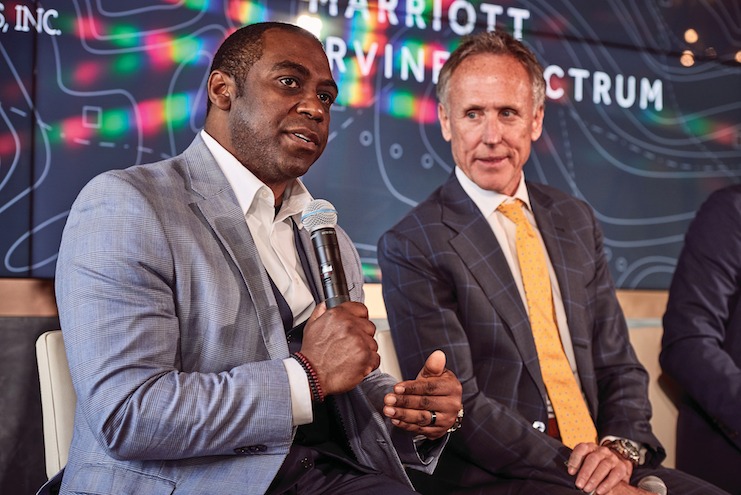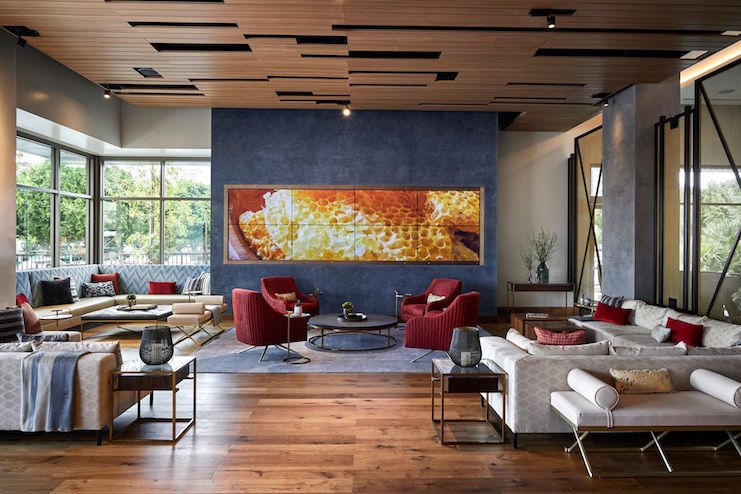
Julius Robinson, who is currently Marriott International’s senior vice president of classic premium full service brands, might be something of a poster child for the concepts of loyalty and legacy. He’s been at Marriott for his entire career, starting when he was working part-time at a call center as a college student more than 25 years ago. He described his own ever-evolving path to his current position, and shared with LODGING his thoughts on how legacy brands, such as Marriott Hotels and Sheraton, can maintain customer loyalty built up over decades, and otherwise advantageously leverage their reputation and size in today’s competitive environment.
Robinson claims he knew next to nothing about the hospitality industry when he took a part-time job at a Marriott call center near the Rutgers University Campus, where he was a junior. “I had been to hotel restaurants with friends and family for special occasions, like Mother’s Day and weddings, but the call center was very different from food and beverage, and there was no hotel in sight. Yet in working the phones, helping people make their reservations, I learned about the industry from their perspective—what mattered to them as hotel guests,” he recalls.
Robinson had the chance to learn much more once working at an actual hotel property, the Marriott Saddlebrook in Saddlebrook, N.J.—one of the first dozen hotels in the Marriott system. As a manager at this small hotel, he learned about what it took to actually run a hotel that served both leisure and business travelers. “I had to do it all—everything from front desk to catering or even sometimes helping out in housekeeping. This gave me an opportunity to learn from both business and leisure travelers what they value, the things that make a hotel stay special,” he says.
As much as he learned while working in the front of the house, what really jump-started his career, he says, was moving to the back of the house. “I got the bug for a new business line in the industry called ‘revenue management,’ something people began to understand in the mid to late 90s. I went from working in regional capacities to working at headquarters in a similar capacity.” After that were positions in increasingly responsible positions, including working in owner group and owner franchise services, during which he forged solid relationships with Marriott’s legacy owner community, and serving as global sales vice president, a role that leveraged his experience into that of an effective brand leader for Marriott Hotels and Sheraton brands.
Robinson credits his long and somewhat leisurely climb up the professional ladder with providing the depth and range of experience that ideally qualified him to assume his current position overseeing Marriott Hotels and Sheraton, the company’s two flagship legacy brands. Robinson stresses the value of being steeped in the Marriott culture over time. “Nearly all of us who have been with Marriott for more than 20 years have ‘done time’ with those brands while rising through the organization. Having this experience, especially with Marriott as the first brand, enables us to view the entire organization through the lens of Marriott Hotels as the company evolved, so we can connect those early days to what is happening now and what may occur in the future,” he says.
“That relationship guests have with the brand must be evident no matter where they’re traveling anywhere in the world. For guests who travel with these brands in particular, the essence of hospitality is tangible and relevant.”
Describing the enduring appeal of legacy brands, Robinson states, “I like to call Marriott and Sheraton ‘timeless trust marks,’ which is what they are for both the industry and the company. These brands that people know and trust are timeless; they have the largest footprint in terms of the distribution of our full-service portfolio, and they are also in the most countries around the world.” Maintaining their position, Robinson says, requires protecting their reputation and that all-important guest relationship, which is ultimately the driving force behind all loyalty programs. “That relationship guests have with the brand must be evident no matter where they’re traveling anywhere in the world. For guests who travel with these brands in particular, the essence of hospitality is tangible and relevant,” he describes.
Robinson reminds that the legacy brands work on a large canvas. “Unlike targeted brands that focus on one or two specific areas, legacy brands provide a wide spectrum of hospitality services for both business and hospitality guests, including those hosting meetings and events calling for food and beverage.” This, he points out, enables them to build trust over time. However, the lure of legacy and timelessness notwithstanding, they must also keep up with industry trends, which are always changing and always evolving. Further, he adds, as the flagships among numerous Marriott brands and innumerable competitors, they often set the standard for the entire portfolio, so they must tread carefully, with the big picture uppermost in mind. “When you have big brands, you have the opportunity to stay forward by innovating on a constant basis across many different areas, but it needs to done subtly, without the big bang that some brands come out with. The guest experience should be familiar, so innovation introductions must come in small bites. The worst thing legacy brands can do is to try to be something that they’re not. Our focus is to take care of the entirety of the business, while regularly innovating in specific ways,” he says.

Robinson admits that phasing in new ideas, strategies, and technologies while maintaining a timeless quality, too, can be tricky. This, he says, includes tweaks to its image. “We were nervous about changing Sheraton’s iconic logo, which hadn’t been touched in over 50 years,” he says, noting that it involved countless conversations with guests and associates about the different versions being tested. “We wanted to deliver the brand logo in a new and modern way, while also showing respect for the legacy of a brand, which is why we’ve added a tagline that says ‘established in 1937.’ It’s those careful touches that keep these brands fresh and alive and relevant,” says Robinson.
In general, he says, everything must be done with care and deliberation, with an eye on the past as well as the future. “We want to make sure that the things we do in these brands are not gimmicky. They must have lasting value from the hotel side while also creating value for the guests. You have to do it in a way that doesn’t scare people, but keeps them intrigued about what these brands have to offer,” he explains. He notes, too, the ripple effect of all decisions affecting the legacy brands. “Because they have such a large footprint, when you roll things out in these brands, the world knows what’s happening. You have to bring the future into these hotels, but you have to do it in a way that’s scalable,” he says.
Robinson stresses the importance of feedback to guide decision-making related to tinkering with these classic premium brands, whose sustained performance as well as their reputation continue to attract owners as well as guests. “We have strong relationships with owners, and work closely with them and various advisory boards, which allows us to constantly receive feedback.” Such feedback, he says, supports the good news: “The good news for owners about having brands like these is that they are highly successful due largely to public perception of their value. Because of their size and scale and their recognition among guests, they are always in the conversation. From an investment perspective, Marriott regards legacy brands as brands we need to continue to invest in.”
He describes some of the ways Marriott Hotels and Sheraton are bringing design changes to those traditional flags to make them more modern, but also maintain the spirit of their heritage. He says Marriott Hotel’s new room design, which is now in more than half of the portfolio around the world, is the highest-performing guestroom in the brand’s history. “It is not so fashion- forward that it puts people off. It’s a combination of honest meets polished, which involves using woods and metals and bringing the aesthetic together in a very sophisticated way.”
He says that updates to Sheraton properties required understanding how the Sheraton and Marriott concepts of legacy differed. “Our approach to Sheraton focused on the public area, thinking of the Sheraton lobby as the future of the world’s gathering place. Guests will come together around food and beverage, around social networking, around business, around gathering. It’s really a co-working and residential environment that we think our guests will love.” These two different approaches, he says, both respect the legacy of those brands, “but with a nod towards our future traveler.”

Robinson maintains that guests—especially those attracted to the legacy brands—aren’t necessarily focused on loyalty programs per se, though those programs do play an important role in customer retention. “They are looking for a guest experience and choosing the brand that fits their trip purpose and their travel journey. Guests seeking great brands that are wrapped into a portfolio as strong as Marriott’s Bonvoy get the best of both worlds. Within this single loyalty program, they have the ability to try different experiences across many different locations around the world.”
Robinson likens the diverse opportunities the different Marriott brands offer guests with the opportunities the company has offered him professionally. “Over the past 25-plus years, I’ve had numerous opportunities and new experiences in my career, and they’ve all been under the umbrella of Marriott International, which has been phenomenal for me.”
He observes concern about the prospect of a pullback in the industry but believes the key to successfully riding the industry’s ups and downs hasn’t changed over the years, despite dramatic changes in the hospitality environment. In fact, he believes the trust factor inherent in legacy brands places them at an advantage with guests in uncertain times. “We just need to double down on the guest experience, keeping in mind that, unlike guests of the past, today’s guests see travel as a rite of passage, so experiences drive where they spend their dollars.” For that reason, he says, building loyalty boils down to providing experiences that guests trust. “If we do that, there will be a constant drumbeat of opportunity in these brands and across our industry. I think in times of economic distress, people are looking for brands that they know and trust. We want to make sure our guests are creating memories, because when they’re doing that, they’re less likely to focus on cost.”
Robinson sees a bright future, as well as an illustrious past, for Marriott Hotels and Sheraton that is rooted in the principles that continue to guide these legacy brands. “Brands have come and gone during the 62 years Marriott and 82 years Sheraton have existed as brands and operations. The very fact that they are still here, they are still innovating, and they are the anchors the Bonvoy platform Marriott’s created with over 30 brands says it all. We see the role of these two brands as important as ever in taking Marriott to the next level of where hospitality is going,” concludes Robinson.












Julius Robinson was my call center supervisor in good old Somerset, NJ! My foundation with hospitality started there and have been enjoying the ride ever since. Congratulations Julius well deserved!
This was a great inspirational story of personal growth and the tenacity to expand Marriott market share.